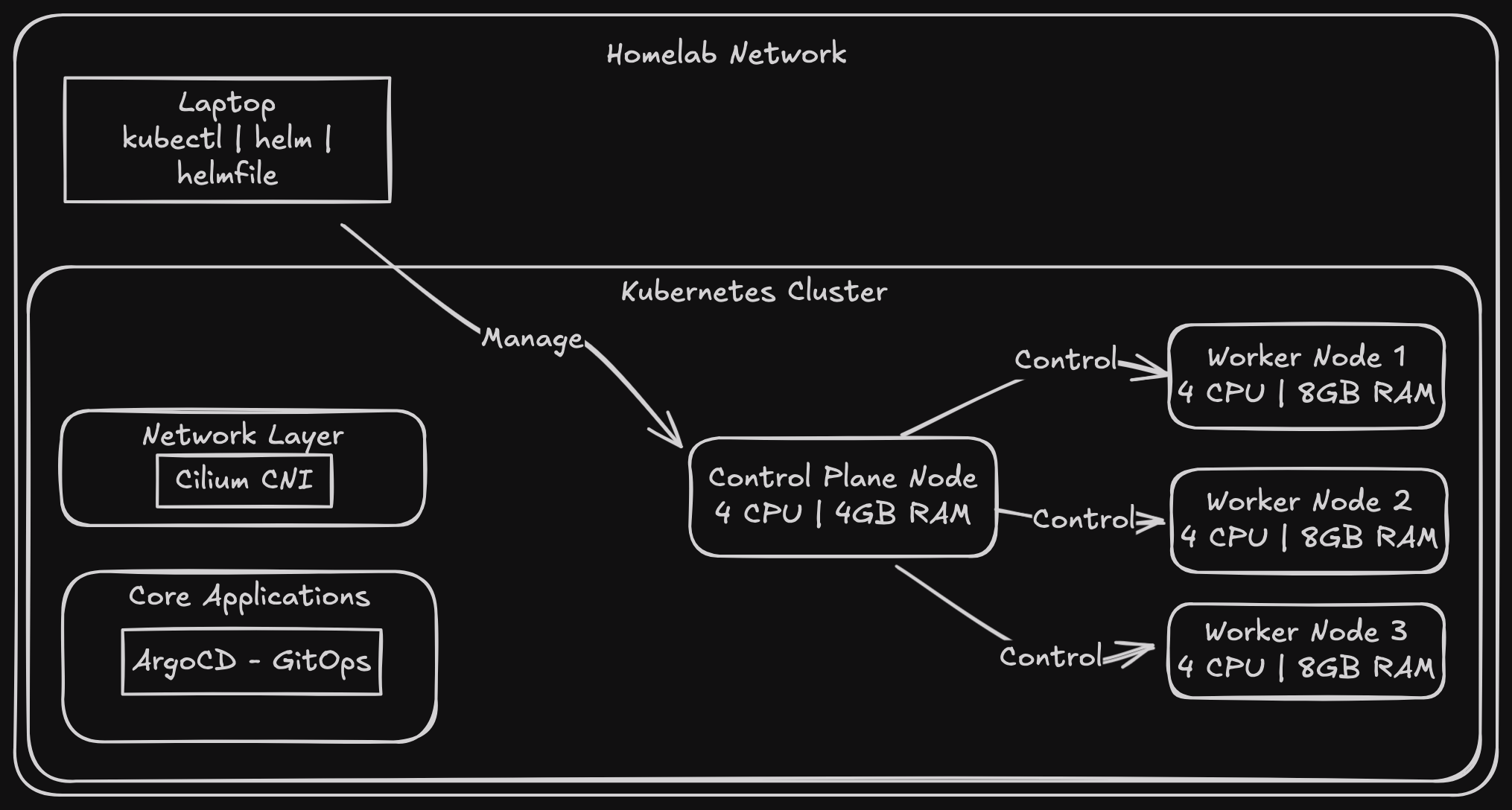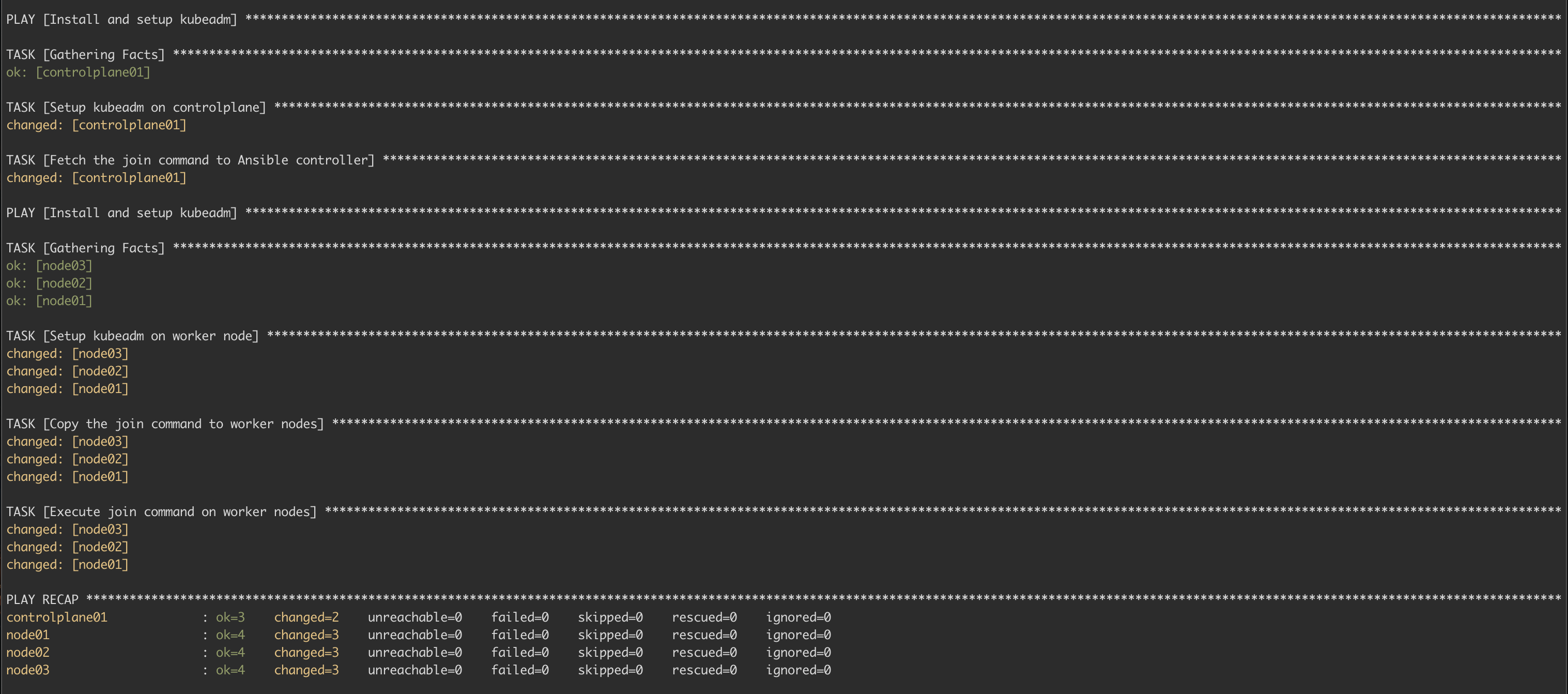Buildlog genesis - Single control-plane kubernetes homelab
2024-11-06

So I decided to build a Kubernetes cluster at home. Sure, I could say it’s mainly for self-hosting + probably ML (I will need to add a GPU node) workloads I want to experiment with, but honestly, I’ve always wanted a homelab to tinker with. Having a proper test environment to break things in beats trying stuff out in production plus is plenty satisfying.
The plan
- 1 control plane node (future HA, but let’s not get ahead of ourselves)
- 3 worker nodes (because why not)
- IP address management (MetalLB)
- I plan to use traefik later as the ingress controller
- A way to manage it all (enter Terraform/Tofu and Ansible)
The Build
VM specifications
These are just what I chose for now, but I’ll modify them as needed
The controlplane has:
- num_cpus = 4
- memory = 4GB
- disk = 50GB
The worker nodes have:
- num_cpus = 4
- memory = 8GB
- disk = 100GB
Infrastructure Time
I use OpenTofu (you can replace it with Terraform), and a custom provider that runs a bunch of CLI commands to provision the instances.
In tofu land:
module "cp_nodes" {
source = "./modules"
cpus = var.cp_compute_properties.cp_num_cpus
memory = var.cp_compute_properties.cp_memory
disk = var.cp_compute_properties.cp_disk
instance_addresses = var.control_plane_instance.cp_ip_addresses
instance_nodes = var.control_plane_instance.cp_instance
cloudinit_file = "${path.module}/setup/user_data.cfg"
hosts = "${path.module}/setup/hosts"
setup_script = "${path.module}/setup/setup.sh"
image = var.ubuntu_image
}
module "worker_nodes" {
source = "./modules"
cpus = var.worker_compute_properties.worker_num_cpus
memory = var.worker_compute_properties.worker_memory
disk = var.worker_compute_properties.worker_disk
instance_addresses = var.worker_nodes_instance.worker_ip_addresses
instance_nodes = var.worker_nodes_instance.worker_instance
cloudinit_file = "${path.module}/setup/user_data.cfg"
hosts = "${path.module}/setup/hosts"
setup_script = "${path.module}/setup/setup.sh"
image = var.ubuntu_image
}
Kubernetes Bootstrap - Enter Ansible
First sign of life - nodes responding (always start with a ping test):
➜ ~ ansible all -m ping -i inventory.ini
node02 | SUCCESS => {
"changed": false,
"ping": "pong"
}
controlplane01 | SUCCESS => {
"changed": false,
"ping": "pong"
}
node03 | SUCCESS => {
"changed": false,
"ping": "pong"
}
node01 | SUCCESS => {
"changed": false,
"ping": "pong"
}
After manually setting it up (running into issues and finally figuring it out, I will probably note it somewhere one day) and tearing it down a couple of times the next logical step was to use ansible to set this all up for me.
My inventory:
[controlplanes]
controlplane01
[nodes]
node01
node02
node03
and playbook
- name: Install and setup kubeadm
hosts: controlplanes
tasks:
- name: Setup kubeadm on controlplane
ansible.builtin.script: kubeadm.sh -controlplane
register: results
# - debug:
# var: results.stdout
- name: Fetch the join command to Ansible controller
ansible.builtin.fetch:
src: /tmp/kubeadm_join_cmd.sh
dest: "{{ playbook_dir }}/files/kubeadm_join_cmd.sh"
flat: yes
- name: Install and setup kubeadm
hosts: nodes
tasks:
- name: Setup kubeadm on worker node
ansible.builtin.script: kubeadm.sh
register: results
# - debug:
# var: results.stdout
- name: Copy the join command to worker nodes
ansible.builtin.copy:
src: "{{ playbook_dir }}/files/kubeadm_join_cmd.sh"
dest: /tmp/kubeadm_join_cmd.sh
mode: '0755'
- name: Execute join command on worker nodes
ansible.builtin.command:
cmd: sudo /tmp/kubeadm_join_cmd.sh
and the shell script kubeadm.sh (i am not particularly any good at shell scripts)
ARG=$1
sudo swapoff -a
# Load required kernel modules
sudo modprobe overlay
sudo modprobe br_netfilter
# Persist modules between restarts
cat <<EOF | sudo tee /etc/modules-load.d/k8s.conf
overlay
br_netfilter
EOF
# Set required networking parameters
cat <<EOF | sudo tee /etc/sysctl.d/k8s.conf
net.bridge.bridge-nf-call-iptables = 1
net.bridge.bridge-nf-call-ip6tables = 1
net.ipv4.ip_forward = 1
EOF
# Apply sysctl params without reboot
sudo sysctl --system
sudo apt-get install -y containerd
sudo mkdir -p /etc/containerd
containerd config default | sed 's/SystemdCgroup = false/SystemdCgroup = true/' | sudo tee /etc/containerd/config.toml
sudo systemctl restart containerd
KUBE_LATEST=$(curl -L -s https://dl.k8s.io/release/stable.txt | awk 'BEGIN { FS="." } { printf "%s.%s", $1, $2 }')
sudo mkdir -p /etc/apt/keyrings
curl -fsSL https://pkgs.k8s.io/core:/stable:/${KUBE_LATEST}/deb/Release.key | sudo gpg --dearmor -o /etc/apt/keyrings/kubernetes-apt-keyring.gpg --yes
echo "deb [signed-by=/etc/apt/keyrings/kubernetes-apt-keyring.gpg] https://pkgs.k8s.io/core:/stable:/${KUBE_LATEST}/deb/ /" | sudo tee /etc/apt/sources.list.d/kubernetes.list
sudo apt-get update
sudo apt-get install -y kubelet kubeadm kubectl
sudo apt-mark hold kubelet kubeadm kubectl
sudo crictl config \
--set runtime-endpoint=unix:///run/containerd/containerd.sock \
--set image-endpoint=unix:///run/containerd/containerd.sock
cat <<EOF | sudo tee /etc/default/kubelet
KUBELET_EXTRA_ARGS='--node-ip ${PRIMARY_IP}'
EOF
if [ "$ARG" = "-controlplane" ]; then
POD_CIDR=10.244.0.0/16
SERVICE_CIDR=10.96.0.0/16
LB_IP=$(getent hosts lb | awk '{ print $1 }')
NODE_HOSTNAME=$(hostname)
# Initialize only if it's the primary control plane
if [ "$NODE_HOSTNAME" = "controlplane01" ]; then
sudo kubeadm init --pod-network-cidr $POD_CIDR \
--service-cidr $SERVICE_CIDR --apiserver-advertise-address $PRIMARY_IP \
--apiserver-cert-extra-sans lb > /tmp/kubeadm_init_output.txt
# Capture join command for other control planes
cat /tmp/kubeadm_init_output.txt | grep "kubeadm join" -A 1 > /tmp/kubeadm_join_cmd.sh
chmod +x /tmp/kubeadm_join_cmd.sh
mkdir -p $HOME/.kube
sudo cp -i /etc/kubernetes/admin.conf $HOME/.kube/config
sudo chown $(id -u):$(id -g) $HOME/.kube/config
else
# For additional control planes later
echo "TODO: modify the join command to join as a control plane"
fi
fi
Running an ansible-playbook -i inventory.ini playbook.yaml which uses the shell script and the playbook to set up the control plane and workers.

Copying the kubeconfig to my laptop scp -i ~/.ssh/labkey ubuntu@controlplane01:~/.kube/config ~/.kube/config
Finally, the moment of truth:

Current progress
- Nodes responding
- Basic connectivity working
- kubectl get nodes shows nodes (NotReady nodes but they show up)
The nodes needed a CNI solution to get them Ready. While setting up the CNI, I figured I might as well install MetalLB and ArgoCD too.
I chose Cilium after seeing it at KubeCon Paris this year - after trying it out, I was so impressed it became my go-to CNI solution.
Instead of using kubectl apply (so 2020! Just picking a random year in the past), I went for a more everything as code approach with Helmfile - a declarative spec for deploying helm charts.
The process is straightforward:
- create a
helmfile.yaml - add your charts
- run
helmfile apply, and wait for the magic to happen.
The helmfile contents:
repositories:
- name: argo
url: https://argoproj.github.io/argo-helm
- name: cilium
url: https://helm.cilium.io/
- name: metallb
url: https://metallb.github.io/metallb
releases:
- name: argocd
namespace: argocd
chart: argo/argo-cd
version: 7.7.0
values:
- server:
extraArgs:
- --insecure
- name: cilium
namespace: kube-system
chart: cilium/cilium
version: 1.16.3
- name: metallb
namespace: metallb-system
chart: metallb/metallb
version: 0.14.8
a few seconds to a minute later and … She’s alive!
k get nodes -o wide
NAME STATUS ROLES AGE VERSION INTERNAL-IP EXTERNAL-IP OS-IMAGE KERNEL-VERSION CONTAINER-RUNTIME
controlplane01 Ready control-plane 11m v1.31.2 192.168.50.100 <none> Ubuntu 22.04.5 LTS 5.15.0-122-generic containerd://1.7.12
node01 Ready <none> 10m v1.31.2 192.168.50.97 <none> Ubuntu 22.04.5 LTS 5.15.0-122-generic containerd://1.7.12
node02 Ready <none> 10m v1.31.2 192.168.50.98 <none> Ubuntu 22.04.5 LTS 5.15.0-122-generic containerd://1.7.12
node03 Ready <none> 10m v1.31.2 192.168.50.99 <none> Ubuntu 22.04.5 LTS 5.15.0-122-generic containerd://1.7.12
and the container creation problem is gone
➜ ~ k get po -A
NAMESPACE NAME READY STATUS RESTARTS AGE
argocd argocd-application-controller-0 1/1 Running 0 2m33s
argocd argocd-applicationset-controller-858cddf5cb-pfffm 1/1 Running 0 2m34s
argocd argocd-dex-server-f7794994f-8r5sg 1/1 Running 0 2m34s
argocd argocd-notifications-controller-d988b477c-95g5m 1/1 Running 0 2m34s
argocd argocd-redis-5bd4bbb-5jkg5 1/1 Running 0 2m34s
argocd argocd-repo-server-6d9f6bd866-4kkcv 1/1 Running 0 2m34s
argocd argocd-server-7b6f64dd8d-d7rlv 1/1 Running 0 2m34s
kube-system cilium-82nxh 1/1 Running 0 3m25s
kube-system cilium-82qdp 1/1 Running 0 3m25s
kube-system cilium-8hnqm 1/1 Running 0 3m25s
kube-system cilium-8l9g5 1/1 Running 0 3m25s
kube-system cilium-envoy-gppg7 1/1 Running 0 3m25s
kube-system cilium-envoy-qdpwc 1/1 Running 0 3m25s
kube-system cilium-envoy-s4js7 1/1 Running 0 3m25s
kube-system cilium-envoy-vbhnv 1/1 Running 0 3m25s
kube-system cilium-operator-b4bfbfd9c-6cr4q 1/1 Running 0 3m25s
kube-system cilium-operator-b4bfbfd9c-mvhnd 1/1 Running 0 3m25s
kube-system coredns-7c65d6cfc9-4pt49 1/1 Running 0 11m
kube-system coredns-7c65d6cfc9-8qn75 1/1 Running 0 11m
kube-system etcd-controlplane01 1/1 Running 0 11m
kube-system kube-apiserver-controlplane01 1/1 Running 0 11m
kube-system kube-controller-manager-controlplane01 1/1 Running 0 11m
kube-system kube-proxy-2dr96 1/1 Running 0 10m
kube-system kube-proxy-2s96q 1/1 Running 0 10m
kube-system kube-proxy-kwn5v 1/1 Running 0 10m
kube-system kube-proxy-qlfb2 1/1 Running 0 11m
kube-system kube-scheduler-controlplane01 1/1 Running 0 11m
metallb-system metallb-controller-6c9b5955bc-vnrcb 1/1 Running 0 3m24s
metallb-system metallb-speaker-22lwz 4/4 Running 0 2m56s
metallb-system metallb-speaker-4jgnf 4/4 Running 0 2m58s
metallb-system metallb-speaker-6cm5m 4/4 Running 0 2m55s
metallb-system metallb-speaker-fxq4t 4/4 Running 0 2m58s
Notes
- Always check container runtime config first
- Debugging:
- Network connectivity
- Container runtime
- kubelet logs
- Pod logs
- Keep join tokens somewhere safe
- Screenshot working configs (trust me)
Up Next
- Planning HA control plane
- Need to figure out:
- Load balancer for API server
- Backup strategy (probably should have thought of this earlier)
Note to readers: This is a not a tutorial. Your mileage may vary, and that’s the fun part!
